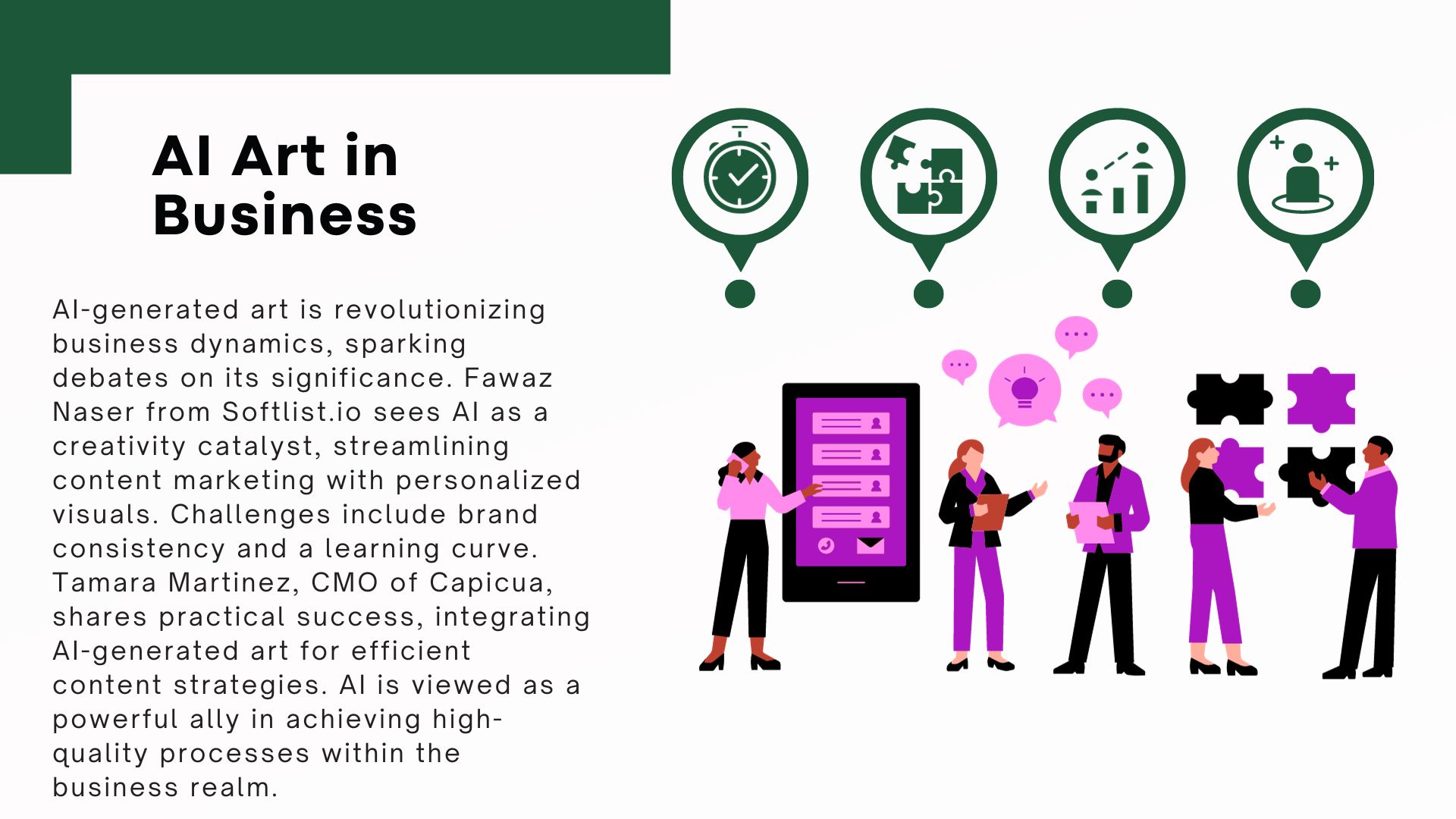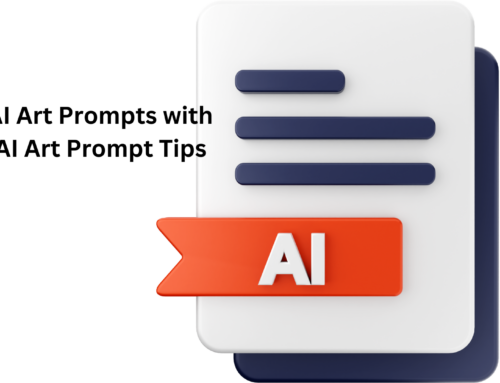In the dynamic landscape of modern business, the infusion of technology and creativity has given rise to a fascinating phenomenon: AI-generated art. This merge of artificial intelligence and artistic expression has sparked debates and discussions across industries, with some hailing it as a groundbreaking redefinition of aesthetics while others dismiss it as a passing trend.
As businesses explore the potential of AI to add a new dimension to their creative endeavors, the question arises: Is AI art a genuine evolution of aesthetic expression, or is it simply a trend driven by the allure of cutting-edge technology? To gain insights, let’s explore the perspectives of experts.
Fawaz Naser, a leader in the SaaS industry and the CEO of Softlist.io, believes that AI has the power to unlock new realms of creativity. He says “As a Digital Marketing Manager, my team and I have been effectively utilizing AI-generated art to enhance our content marketing campaigns. We’ve seen a notable increase in engagement and click-through rates by using AI to create personalized visuals for email and social media campaigns. Tailoring these images to reflect the diverse interests of our audience segments has been a game-changer in terms of personalization.
We’ve also embraced AI art for dynamic content creation on our website and digital platforms. In my opinion, Ai-generated art are cost-effective because it saves us time, effort and the need to hire a graphic artist for our content marketing and web design efforts. The ability of AI to quickly produce varied and striking graphics has been invaluable. It allows us to keep our content vibrant and relevant, adapting swiftly to the evolving themes of our campaigns. This agility is particularly crucial in the fast-paced digital realm where content freshness is key to maintaining audience interest.
However, integrating AI-generated art into our marketing strategy hasn’t been without challenges. Maintaining brand consistency has been a primary concern. AI-generated visuals can sometimes stray from our established visual identity, requiring us to set stringent guidelines and conduct regular reviews of the outputs. Also, there’s been a learning curve with these AI tools. Both our technical staff and creative team have had to adapt and grow their skills to harness the full potential of AI in our marketing endeavors.”
On the practical side of the spectrum, Tamara Martinez, CMO of Capicua, emphasizes the applications of AI art in business. “At Capicua, we started leveraging AI-generated art for our Content Strategy at the beginning of 2023. While we leaned onto that approach mostly to understand the extent of T2I tools and platforms, we harnessed the knowledge and strategic experience of our UX/UI Design Team to ensure smooth results that may escape the non-technical eye. AI-generated art allowed us to create outstanding graphic concepts for our blog articles and content distribution via social media in much more efficient ways. Since then, we have seen a huge growth in marketing metrics, with captivating and engaging visual assets to reach different types of users. Currently, counting on Artificial Intelligence to create the assets real-life users love is part of our strategy!
Regarding this phenomenon, we like to think of AI as a powerful coworker that helps faster, high-quality processes. Artificial Intelligence works as a great extension of human knowledge, and it seems there is no limit as to what that joint work can achieve. There’s definitely nothing short-lived about that!”

How AI Art is Reshaping the Business Landscape?
In the ever-evolving landscape of business aesthetics, AI art has emerged not just as a fleeting trend but as a powerful force ready to redefine creativity. Algorithms embedded in AI systems have become the new artists, pushing the boundaries of what we thought possible. These algorithms, powered by machine learning, can now create art that challenges traditional notions of human craftsmanship. As we witness this remarkable advancement, it’s clear that AI has the potential to reshape how we perceive and curate art in the business world.
The generative power of AI algorithms goes beyond mere replication; it’s a true revolution in the art space. With the ability to program AI to think creatively, businesses can curate unique and innovative pieces that were once solely in the realm of human imagination. This progression doesn’t just stop at redefining aesthetics; it’s a paradigm shift that forces us to reconsider the very essence of artistic expression in the business domain. AI art is not just a trend; it’s an advancement that has the potential to revolutionize the way businesses approach creativity and reshape the visual language they use to communicate with their audience.
Generative Adversarial Network and the Evolution of Business Aesthetics
As we delve into the fascinating world of AI art within the business realm, the redefinition of aesthetics with artificial intelligence unfolds as a captivating narrative. AI generated art, powered by the potential of AI technology, stands at the intersection of tradition and innovation. It’s more than just a passing trend; it’s an evolution that transcends traditional art forms. Imagine AI algorithms creating unique pieces by analyzing vast amounts of data, a feat that was once solely attributed to human creativity.
The canvas of AI art is painted with the strokes of generative AI, where algorithms, especially generative adversarial networks (GANs) and neural networks, converge to craft visual masterpieces. This goes beyond mere imitation; AI becomes a co-creator, producing artworks that challenge our perceptions and redefine aesthetics. Take, for example, the mesmerizing artworks generated by the AI model DALL-E, showcasing how AI in art can stretch the boundaries of imagination. In this fascinating intersection of AI and artistic expression, the potential of AI tools to reshape aesthetics becomes evident, opening up new possibilities for businesses to embrace creativity in unprecedented ways.
Ethical Considerations in the Integration of Art and Technology
Venturing further into the captivating world of AI art within the business landscape, the potential of AI and machine learning to redefine aesthetics takes center stage. AI has proven itself not merely as a tool but as a transformative force in the intersection of AI and art technology. As advancements in AI continue to unfold, the rise of AI art becomes an exciting journey, showcasing its ability to go beyond trends and leave a lasting impact.
Consider the relationship between AI, deep learning, and the creation of aesthetically pleasing art. Through the integration of AI, the human touch and the machine’s precision converge, forging a unique synergy. The ethical considerations surrounding AI-generated content and art are crucial in navigating this terrain. For instance, the type of AI utilized, whether it’s supervised learning or generative AI, plays a significant role in shaping the output. Let’s explore this fusion further through some key points:
- Ethical Concerns: As AI-generated art becomes prevalent, questions arise about authorship and the ethical use of AI tools in the creative process.
- Dataset Diversity: The diversity of the dataset used by AI influences the richness and variety of the generated art, emphasizing the importance of responsible data curation.
- Deep Learning Magic: The magic of deep learning lies in its ability to analyze patterns and nuances, allowing AI to produce art that goes beyond the surface and delves into the intricacies of visual aesthetics.
In this dynamic field of AI-generated art, understanding the nuances of AI’s potential, ethical considerations, and the fusion of art and technology is essential. As a tool, not only is AI redefining aesthetics but also invites us to ponder the evolving relationship between creativity and artificial intelligence technology.

The Impact of Airbrush AI in Visual Creation
In the dynamic world of business branding, the emergence of AI has paved the way for groundbreaking tools like Airbrush AI, a text-to-image generator that’s pushing the boundaries of art. This innovative tool leverages algorithmic art to create visuals that go beyond the ordinary, making it a game-changer in the branding landscape. Here are five features and benefits that make Airbrush AI an invaluable asset in maximizing impact for business branding:
- Algorithmic Brilliance: Airbrush AI utilizes advanced algorithms to create visually stunning and unique art, ensuring that each piece stands out and captivates the audience.
- Social Media Amplification: Tailored for the modern era, Airbrush AI’s creations are perfect for social media platforms, where eye-catching visuals are essential. It helps brands make a memorable impression on platforms like Instagram, where visuals play a crucial role in engagement.
- Data Mastery: The tool is trained on vast datasets, allowing it to process large amounts of data efficiently. It can learn from this data and generate art that resonates with specific target audiences, contributing to highly personalized branding.
- Pattern Recognition: Airbrush AI goes beyond mere image creation; it can analyze data to identify patterns, ensuring that the generated visuals align seamlessly with the brand’s identity and messaging.
- Human-AI Collaboration: While Airbrush AI is a powerful tool, it recognizes the importance of the human touch. It complements the role of human creativity, offering a collaborative approach that enhances the overall branding process.
However, it’s crucial to acknowledge the potential for misuse, as with any powerful tool. As we embrace the role of AI in branding, it’s essential to ensure ethical usage and maintain a balance between technological innovation and the human touch. Airbrush AI stands as a testament to the fascinating intersection of art and technology, providing brands with a dynamic means to elevate their visual presence in the competitive world of business branding.
Closing Thoughts on How Is AI Redefining Aesthetics in Business Art
In conclusion, as AI becomes more ingrained in business aesthetics, we’re heading towards a future where AI and humans work together to redefine artistic expressions. The evolution of AI has transformed how we see art, with AI-created pieces playing a significant role. Whether AI is seen as a trend or a lasting transformation, one thing is clear – it has opened up new possibilities. AI’s ability to streamline creative processes, generate art from vast datasets, and collaborate with human creativity creates a synergy that not only boosts our artistic efforts but also paves the way for a harmonious relationship between humans and machines in the world of aesthetics. As we witness this dynamic interplay between technology and creativity, it’s clear that AI hasn’t just entered the scene; it’s become a transformative force shaping the future of art in business.






Leave A Comment